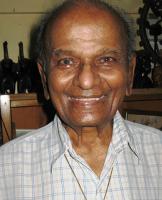Tribute to Kantilal Jivan Shah 1922-2010-Goodbye my friend |30 October 2010

Kanti was well known internationally, and the Nordic countries seemed to have correctly described him as “a man of many parts”. Certainly he was, because he was a good photographer, businessman, numismatist, philatelist, entomologist, historian, naturalist, conchologist, art collector, cartographer, herbalist – and a very good cook.
He was for la Francophonie and was forever a devoted tourism ambassador, always very kind and polite to foreign visitors. He was also a supporter and contributor to the Tutorial College set up by the late Guy Morel for drop-out students.
However, it should not be forgotten that Kanti was also a politician, and in 1965 he was among the first elected members of Victoria District Council; he was voted in to represent the Pier Ward and later acted as chairman.
He started to be a numismatist at a very young age while he was at school at St Louis College, which was run by the Marist Brothers. There he was encouraged by his teacher Brother Philogone (Angelo Mecci Philogono of Italy), who was the first person to introduce Italian bees to Seychelles.
Kanti’s knowledge of money and old maps of the Indian Ocean was vast, and I learned a lot from him.
Over the years he met many towering personalities, such as Prince Philip, Duke of Edinburgh during the Duke’s visit to Seychelles in 1957, and later Queen Elizabeth II and Mother Teresa. During the visit of Prince Philip, Kanti and his wife acted as photographers.
One of his early achievements was to save the Venn’s Town (Mission) ruins and the Bel Air cemetery from destruction. He managed to alert the authorities to stop the Public Works Department using stones from Venn’s Town to build a nearby public road.
Kanti had profound respect for two brilliant Seychellois doctors, Tony D’Offay FRCS and Constant L D Hermitte, who was an expert on the seashells found in Seychelles. It was reading the works of Hermitte at the Carnegie Library that led Kanti to become a conchologist.
However, in that field and also that of butterflies he worked closely with the naturalist Archie Wood, who became his mentor. Part of their collections of shells and butterflies is now in the Umtali Museum (in 1982 Umtali became Mutare, which is now in Zimbabwe). The museum was built in 1957, and the project was initiated by Wood.
Kanti had the best collection of early law books of Seychelles. He helped me immensely, and quite recently, to compile documents for my next project on the history of Seychelles’ jurisprudence and the imposition of law.
Even though most of the documents in question were not still in his possession, his references to them were precise. It led me to find them in the British Museum library, where I once attended a short bookbinding course.
Kanti also had an exceptionally good knowledge of the famous Code Caen of the early 1800s.
In the colonial days, the registrar of the Supreme Court, and lawyers too, borrowed a lot of material from him and never returned it. Later, even the Roman Catholic Church borrowed a good many photos from his collections.
Even the Seychelles National Archives has some copies of his original photographs, which they do not acknowledge, and at one time that made him quite bitter.
He became more disillusioned still when the authorities burned all the immigration cards and threw away the old museum artefacts that were collected by Captain Webb. Kanti told me that even the collections of books that the son of Guy Lionnet gave to the Seychelles National Archives had disappeared.
After a mild heart attack, Kanti carried on working and refused to take a long rest (much like his famous late brother Nanalal FRCS, Seychelles’ first open-heart surgeon), and as advised by his nephew, Dr Jivan – most probably because he knew that life is short.
He died peacefully at the age of 88 at Victoria hospital as he was comforted by his son.
Amadou Hampâté Bâ, the famous Malian writer and ethnologist, said: “When an old man dies it is a library that is burnt”, and for Kanti, he would have said that Seychelles has lost many libraries.
Sadly, most of his knowledge has gone with him and the oral traditions section, if indeed it does exist, in the Culture Department has failed to grasp that knowledge.
Adieu! My friend, I know I will never see you again, and we will never have a little grog together again. A man of your calibre, so knowledgeable on local history, will be so very hard to replace and may never be found again.
I would like to end with this Hindu prayer quoting from Rig-Veda X, 16,3:
“Let your eye go to the Sun, your life to the wind; by the meritorious acts that you have done, go to heaven, and then (for rebirth) to the earth again; or resort to the Waters, if you feel at home there; remain in the herbs with the bodies you propose to take.”
Julien Durup, a student of history




